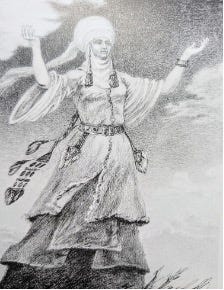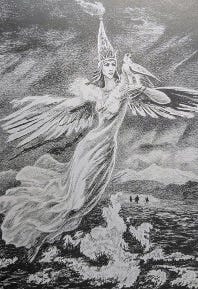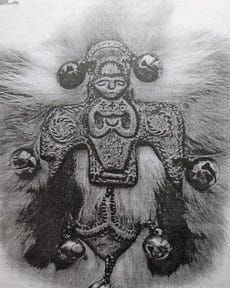Beyond the Binary: The Enduring Power of the Goddess in a Divided World
Next in our Gimbutas and Goddesses series is a set of contributions from graduate students at Pacifica Graduate Institute, beginning with this essay by Aida Kali Kyzy Japarkul
Exploring Ancient Symbols
Twenty-seven years ago, after immigrating from Kyrgyzstan to the United States, I stumbled upon Marija Gimbutas’s archaeomythology, its vivid figurines like the “Nippled Vase” sparking memories of my homeland’s traditions. A Lithuanian archaeologist from another former Soviet state, each with its own rich pre-Soviet heritage, Gimbutas transformed our understanding of Neolithic and Bronze Age cultures in Old Europe. As Joseph Campbell observed, her work unveiled “the universe as the living body of a Goddess-Mother Creator, and of all the living things within it as partaking of her divinity” (Gimbutas xiii).
Gimbutas saw symbols as windows into the mind, revealing how we perceive and interpret the world. As Descartes noted, “we are directly aware not of an object in the world but of representations in our minds” (Thompson 98). She believed symbols, woven into the broader tapestry of archaeomythology, “cannot be treated in isolation: understanding the parts leads to understanding the whole, which in turn leads to identifying more of the parts” (Gimbutas xi). Each symbol carries a network of meaning, connecting us to ancient wisdom. Through exploring the goddess’s symbolism and mythology, we uncover a vibrant tapestry that binds ancient cultures, feminine spirituality, and our shared quest for wholeness.
Drawing Cultural Connections
To illustrate the broader relevance of Marija Gimbutas’s ideas, I draw a connection between the ancient European symbolism she explored and my Kyrgyz heritage. A striking example is the “Nippled Vase” from Mallia, Crete (end of 3rd millennium BCE), featuring the Bird Goddess (Figure 1). Its headdress has a stark similarity to the Kyrgyz elecheck headdress, a symbol that, for me, recalls Kanatuu Umai – the Winged Umai Goddess – revered alongside the god Tenir in Kyrgyz mythology. Documented in Gimbutas’s The Language of the Goddess (1989), this vessel’s curves and earthy tones embody the archetype of the life-giving mother, its enduring presence a testament to the Bird Goddess’s power across distant cultures.
Figure 1: “Nippled Vase” from Mallia, Crete (end of 3rd millennium BCE), depicting the Bird Goddess with bell-like form, echoing the Kyrgyz elecheck headdress.
This archetype resonates in Kyrgyz mythology, where Umai’s vivid illustrations in Kyrgyz Women in Myths and Legends (Bekturganova 8, 131) capture the sacred feminine (Figure 2). Adorned with a tubular elecheck headdress, her serene presence evokes divine protection. With outstretched wings soaring over the Tian Shan mountains, her vibrant feathers symbolize celestial freedom akin to Gimbutas’s Bird Goddess. In intricate leather and fur ornaments, her wings reflect a life-giving force woven into Kyrgyz traditions. Cradling a newborn hero, she radiates light, embodying her role as a nurturing mother who gifts life and purpose. Umai’s images bridge the ancient Kyrgyz reverence with the universal goddess archetype, their transformative power soaring across cultures and time.




Figure 2: Winged Umai Goddess, a Kyrgyz symbol of creation and protection.
In the ancient Kyrgyz culture, the woman was a divine creation, revered as “Umai Ene,” the Woman-Mother, embodying a matristic-gylanic culture i.e. a balanced partnership between feminine and masculine principles (Bekturganova 28; Gimbutas xviii). These symbols may have traveled via the Silk Road, where Kyrgyz tribes on the Tian Shan steppes wove oral epics reflecting prehistoric goddess reverence. Controlling ancient trade routes, they engaged with civilizations like the Chinese, Mongols, and Sogdians. Kyrgyz mythology casts Umai, the Progenitress Mother, and Tenir in a gylany, a society of equality and respect (Gimbutas xviii). Umai’s wings, visualized in intricate ornaments, evoke a feminine power linking Central Asia to Old Europe, a story we can trace through Maureen Murdock’s heroine’s journey of suppression and rediscovery.
Tracing the Heroine’s Journey
The goddess archetype mirrors a universal cycle of transformation, illuminated by Maureen Murdock’s heroine’s journey – a feminist reimagining of Joseph Campbell’s hero’s journey that charts the sacred feminine’s path through self-discovery, suppression, and rediscovery. This framework reveals how the goddess’s enduring power shapes feminine identity and spirituality across time.
Phase One: The Illusion of the Perfect World, Followed by Betrayal
From 30,000 to 3500 BCE, goddess-centric cultures revered the feminine, but Proto-Indo-European societies prioritized the masculine, diminishing her role.
Phase Two: The Awakening and The Descent
As societies shifted, from 3500 BCE to 500 CE, goddesses endured in polytheistic pantheons, yet patriarchal structures and monotheism suppressed their worship.
Phase Three: The Eye of the Storm and the Ascent
From 500 to 1600 CE, mystical traditions safeguarded feminine wisdom, paving the way for feminist movements to revive goddess spirituality.
Phase Four: The Return with the Elixir and Integration of Wholeness
Today, spirituality and feminist theory reclaim the sacred feminine, fostering gylany – a balanced partnership of masculine and feminine principles.
This cycle of reverence, suppression, and rediscovery completes the heroine’s journey, unveiling the goddess’s quest for balance and wholeness in our world.
Embracing The Goddess’ Gift
From the “Nippled Vase” of Crete to Umai’s wings in the Kyrgyz art, the goddess archetype has journeyed through time, guiding us toward balance. Her heroine’s journey, now reborn in our collective consciousness, offers the Lover archetype – a gylanic union of masculine and feminine that transcends division. This sacred feminine is no relic but a vital force for healing our world. What symbols of transformation do you see in your traditions? Share your thoughts in the comments - what symbols inspire you?
Work Cited
Bekturganova, Koolbjubju. Kyrgyz Women in Myths and Legends. pp. 8, 131.
Gimbutas. M. The Language of the Goddess. Harper & Row, Publisher. San Francisco. 1989.xiii-17.
Jung, C. The Archetypes and the Collective Unconscious. Princeton. 1977. 512.
Thompson, Introduction to Philosophy. Lancaster University. London.1998. Accessed on March 28, 2025. Accessed from https://www.lancaster.ac.uk/users/philosophy/courses/100/100perception.htm
“The Unbearable Whaleness of Being”, Winter 2025, Sculpture medium is Italian Plastilin
Aida Kali Kyzy Japarkul, M.A. in Mythological Studies and Depth Psychology, is a writer and researcher exploring the intersections of mythology, symbolism, culture, and consciousness. With a focus on myth propagation, archaeomythology, and funerary anthropology, Japarkul's work weaves together threads from mythology, depth psychology, astrology, tarology, and shamanism. As a contributor to Opus Archives, Japarkul is a noetic artist harnessing methodologies to unveil latent patterns in ancient mythopoetic expression thus building blueprints for reflexive evolution, a transformative process rooted in self-awareness.






